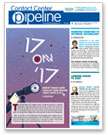
Welcome to 2017! What are the trends that contact center leaders keep an eye on over the next 12 months? Part 3 of our 17 on ’17 series continues with expert insights on voice of the customer, mobile, forecasting & scheduling and quality monitoring. Be sure to check out Part 1 and Part 2 for predictions on additional topics of interest to contact center professionals.
On Voice of the Customer…
RYAN HOLLENBECK
Senior Vice President, Global Marketing
Verint Systems
 A trend that will continue to accelerate in 2017 is the increasing digitization of the voice of the customer, but there is a catch. Verint conducted a global study among more than 24,000 consumers and across 12 countries that reveals consumers still want the option to speak with an actual person, too.
A trend that will continue to accelerate in 2017 is the increasing digitization of the voice of the customer, but there is a catch. Verint conducted a global study among more than 24,000 consumers and across 12 countries that reveals consumers still want the option to speak with an actual person, too.
The takeaway is that it’s important to find a balance in supporting “digital-first” needs and human interactions. As consumers become more digitally savvy, we’re finding that organizations are deploying more cost-effective digital channels as part of their evolving customer engagement strategies. However, the message from consumers is clear. They still want the human touch as an option in more complex customer service scenarios.
This dynamic means that businesses considering more cost-effective, digitally driven channels must ensure that they understand customers’ channel preferences and the influence they have on customer behavior and engagement. Those organizations that tip the balance in favor of digital at the expense of traditional service may risk not keeping their customers happy in the long run. Given this, customer engagement solutions, such as web and mobile self-service, voice/web/mobile/location feedback, speech analytics and knowledge management, will become even more important in the coming year.
On Mobile…
STEVEN KAISH
Vice President, Product Marketing & Alliances
BroadSoft
 1. Omnichannel: The growing use of mobile devices by customers will continue to drive the growth of omnichannel communications in the contact center. Customers may prefer to use chat, email, SMS or social media to engage with customer care organizations. The increasing adoption of and comfort level of customers with mobile technologies, as well as the well-documented preference of millennials to use non-voice communications on mobile devices, will continue to accelerate non-voice customer engagement.
1. Omnichannel: The growing use of mobile devices by customers will continue to drive the growth of omnichannel communications in the contact center. Customers may prefer to use chat, email, SMS or social media to engage with customer care organizations. The increasing adoption of and comfort level of customers with mobile technologies, as well as the well-documented preference of millennials to use non-voice communications on mobile devices, will continue to accelerate non-voice customer engagement.
2. Best-Agent Routing: The proliferation of “work anywhere” technologies, led by Voice-over-IP and completely browser-based agent interfaces, will increase the ability of companies to employ remote and at-home agents. This provides contact center managers with access to a more-skilled and specialized workforce, and enables companies to improve customer service by matching customers with the most appropriate agent to fulfill the particular customer’s needs. This matching becomes possible with use of deep predictive analytics, which can assess both customer tendencies and agent proficiencies to drive contact center routing selections.
3. Unified Communications Integration: Agents will increasingly be able to consult with subject-matter experts on-demand, using mobile-first Unified Communications technologies. These subject-matter experts can be reached anywhere, via whatever device is most convenient. Agents can see the online presence of experts in real-time, and collaborate using the most appropriate communications channel, be it instant messaging, team collaboration, voice, video and desktop sharing, used in any combination. This will improve business results by enhancing agent performance, first-call resolutions and improving customer satisfaction.
On Forecasting & Scheduling…
TIFFANY LaREAU
Certified Workforce Manager
Human Numbers LLC

Key Challenge for 2017: Unlimited Vacation (yikes!). This is an extreme practice that can quickly tank a well-thought-out WFM staffing model. Vacation and all paid time off for that matter, should be properly captured and controlled in the contact center.
Unlimited vacation as an approved practice in our environment really has me shaking my head. This means there is no cap on the number of days that an employee can take. The idea is that employees will be self-disciplined enough that it won’t be abused, and that it will lead to a more engaged, productive workforce. The reality is that these are entitlements, and it doesn’t take long to shift perception about what is owed vs. what is deserved (think of the recent FMLA policy fiasco). In one center that I observed, they used it as a way to attract new-hires. They had read a study that said it would actually reduce the amount of vacation employees used. What it actually did was introduce new problems with absenteeism around holidays, around school calendars, and almost doubled the Monday and Friday absenteeism rate.
Service level and ASA goals are very reactive metrics. Even if you only need to reach the SL goal for the day or week, you still need to plan it to the interval so you will know which periods you will be deliberately sacrificing (by design), but still meeting the total goal, unless you’re willing to carry a large amount of overstaffing.
On Quality Monitoring…
JAY MINNUCCI
Founder and President
Service Agility
 Quality monitoring has been around in our contact centers for a long time, and up until recently, the process had been a bit stale. That’s not to say it was without value—quite the contrary. It’s still a key driver of customer satisfaction, but lately there just hadn’t been a lot of growth in the process.
Quality monitoring has been around in our contact centers for a long time, and up until recently, the process had been a bit stale. That’s not to say it was without value—quite the contrary. It’s still a key driver of customer satisfaction, but lately there just hadn’t been a lot of growth in the process.
So what’s changed? Speech analytics. These systems are becoming more and more popular, and contact centers are starting to grasp how to harness this tool. Where the technology is a bit more mature, frontline leaders are using it to help identify opportunities to improve service skills. Speech analytic tools excel at finding those calls where the wrong phrase is uttered, or voices get a bit too stressed, or customers begin to show frustration. These situations should be rare, but speech analytics can identify them much more quickly than a monitoring program that randomly samples 2% of call volume. That makes this new technology a terrific tool for coaching.
Equally as important, the adoption of speech analytics frees up “traditional” monitoring programs to focus on three important objectives:
- Providing the organization with an accurate trending tool to measure enterprise quality over time.
- Identifying opportunities for training/continuous improvement that cuts across the organization.
- Delivering coaching input for those areas (like accuracy of information) that speech analytic tools have a hard time pinpointing.
In 2017, I expect this trend to continue. Monitoring for individual service skills will rely even more on speech analytics, and traditional quality monitoring will become more enterprise focused. It’s a great example of “the right tool for the job,” and our customers will be the beneficiaries.



